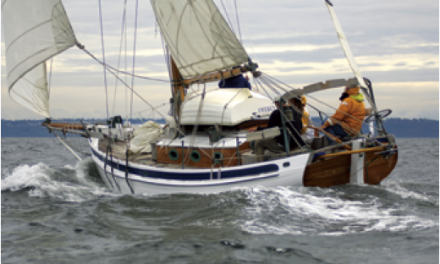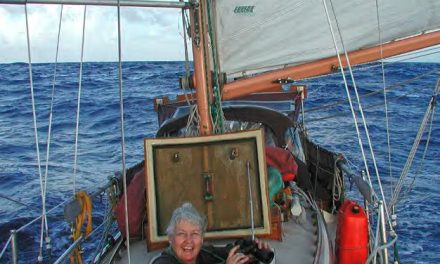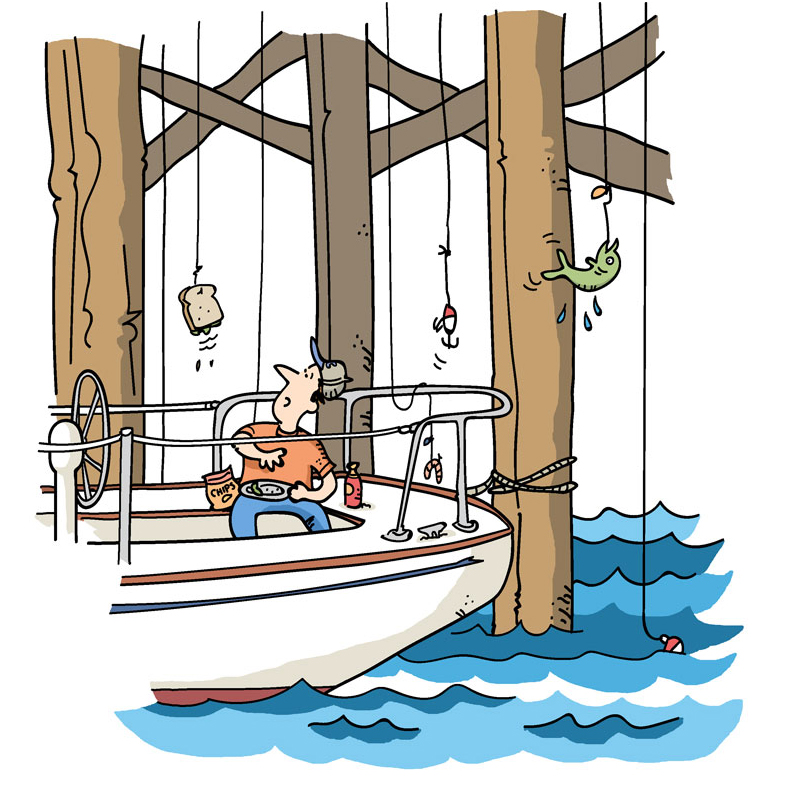Wherein the lack of a head door threatens a happy marriage and worse yet, a cruise.
Issue 141: Nov/Dec 2021
One thing I learned about long-distance cruising under sail—especially aboard boats on the smaller end of the spectrum—is that you must take seriously the requests about which your crew seem particularly adamant. Especially when one of the requesters is your spouse.
Now, let me say at the outset that I favor simple, robust fittings on a sailboat. I don’t think fancy gadgets make good shipmates. In fact, I guess you could classify me as spartan in some ways, because I got along very well aboard my South African-built Performance 31, Freelance, without the trappings of luxury.
Nevertheless, when one is planning to live with one’s spouse and 17-year-old son during a six-month cruise, certain adjustments—what one might even consider lavish additions—are called for. The item in question on this particular cruise was a door to the head.
That’s right, there was no head door aboard Freelance, and no way to isolate the forward part of the boat, where the head was located, from the rest of the boat.

Illustrations by Tom Payne
The matter first came to light during a weekend afloat, a practice run for Freelance’s 7,000-mile cruise from Africa to America, and this “adjustment” was of such a serious nature that my wife, June, made me record it in the ship’s log. The following is a paraphrased account of the event:
A special meeting was held in the main saloon of the yacht Freelance at 2000 hours on Friday.
The business on the agenda was a proposal by the ship’s mate, “That urgent consideration be given to providing a solid wooden door for the toilet.”
The skipper pointed out (very reasonably, he thought) that a door was a fancy gadget that would be difficult—nay, almost impossible—to provide.
The mate said she didn’t care; she wasn’t going cruising with two males without a door on the head.
The skipper then proposed an amendment, saying that male members of the crew would be prepared to make a solemn promise to repair to the cockpit each and every time the mate needed to use the ship’s head.
The mate expressed dissatisfaction with this arrangement, saying she feared it would be impractical on a dark rainy night, for instance, when said males would be loath to leave a warm and comfortable saloon to stand around in a cold and dripping cockpit.
The skipper then offered to provide a curtain that would slide across the entrance to the head, thus ensuring the privacy the mate seemed to require.
The mate, on a point of explanation, then asked the skipper for his definition of “privacy.”
The skipper said “privacy” was patently present when the occupant of the toilet was invisible to others in the near vicinity.
The mate said that in her humble opinion, “privacy” also constituted an element of noise-proofing.
The skipper expressed surprise that ladies made noises in the loo, saying he thought only men did that sort of thing.
The mate said with some asperity that it was none of his business what ladies did in the loo, and would he kindly get on with the meeting?
The skipper then pointed out that, of the seven yachts of the same class as Freelance with which he was acquainted, not one possessed a door to the toilet. In the confined space of the head, he said, a door could not swing without hitting the bowl, the washbasin, the towel rail, the toilet-paper holder, and the gadget that held the baby-wipe dispenser.
The mate said she didn’t care; she wanted a proper door.
The skipper, visibly roused, said he thought it a luxury even to have a toilet on a 30-footer, let alone one with a door. It was just a matter of getting used to it, that was all.
The mate then called for a vote.
When all those in favor of the mate’s motion were asked to say “aye,” the mate said, “Aye.”
When all those against the motion were asked to say “nay,” the skipper said, “Nay.”
This stalemate was eventually resolved by the mate, who informed the skipper he’d be leaving Africa one crewmember short if, at the time of departure, there wasn’t a solid door to the head.
Well, the writing was on the wall, of course. So, with grave misgivings, I set out to design a door for the head. After lots of head-scratching and sketches on the back of yacht club menus, I managed to make an odd-shaped piece of half-inch marine plywood fit the cut-out in the main bulkhead in the saloon.
I hinged it on one side and cut a small notch, so it cleared the bowl of the Lavac toilet. The seat and the lid of the Lavac protruded farther than the bowl. But rather than end up with a door looking like a piece of cheese the rats had nibbled, I opted for the simpler arrangement of lifting the two lids when the door needed to be opened or closed.
When it was finished, the door simply separated the saloon from the forward half of the boat, which included the head, sandwiched between two bulkheads, and the fo’c’s’le.
It was just what the mate wanted, apparently. “It’s lovely,” she exclaimed— and promptly jammed it against the toilet seat.
“Bit awkward to use,” I pointed out.
“Don’t care,” she said. “It’s lovely.”
Over the months we became accustomed to our eccentric loo door, but while most boats provide detailed instructions for the occasional passenger outlining use of the head itself, we also needed them for the door to access said head. They went like this:
To Close Toilet Door:
1. First move right out of toilet area and stand in FORWARD cabin.
2. Reach into toilet area and unlatch door from bulkhead.
3. Lift lid and seat of toilet into upright position.
4. Remove portable wash basin from drop-down flap. Empty contents (if any) into toilet bowl. Raise drop-down flap to upright position.
5. Close door and latch against main bulkhead to starboard.
6. Move into toilet area and read list of instructions for use of toilet.
7. Use toilet.
8. When finished, close seacock marked “A.”
To Open Toilet Door:
1. Move yourself into forward cabin.
2. Reach into toilet area and unlatch door from main bulkhead.
3. Wait 30 seconds, or until hissing noise from toilet has ceased, after which toilet seat should be raised.
4. Check that portable wash basin and flap, if used, are not obstructing movement of door.
5. Close door and latch against bulkhead to port.
Even after it was sanded and varnished, only a mother could truly have loved our loo door. And yet, after having shared with it some of my most intimate moments, I had to confess a growing affection for it. When you got everything right the first time, and it swung closed without knocking anything over or jamming on the seat, you experienced a wonderful glow of satisfaction.
And when you did make the odd mistake, and it stuck fast halfway open, it taught you humility and patience, two qualities much to be admired in seagoing people.
And then there was the fact that it saved our cruise and our marriage. The mate liked it. That was really all that mattered.
There came a time, in fact, when the mate gave ladies from other boats guided tours of our loo. They were very envious. Their unthoughtful husbands made them use curtains. I, on the other hand, was much admired for my sensitivity and understanding.
And naturally, I took all the credit for thinking of the idea in the first place.
John Vigor is a retired journalist and the author of 12 books about small boats, among them Things I Wish I’d Known Before I Started Sailing, which won the prestigious John Southam Award, and Small Boat to Freedom. A former editorial writer for the San Diego Union-Tribune, he’s also the former editor of Sea magazine and a former copy editor of Good Old Boat. A national sailing dinghy champion in South Africa’s International Mirror Class, he now lives in Bellingham, Washington. Find him at johnvigor.com.
Thank you to Sailrite Enterprises, Inc., for providing free access to back issues of Good Old Boat through intellectual property rights. Sailrite.com





